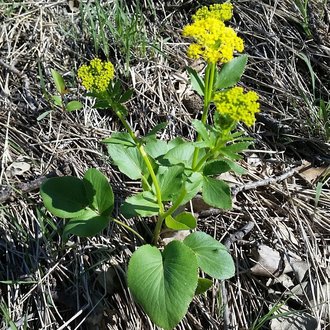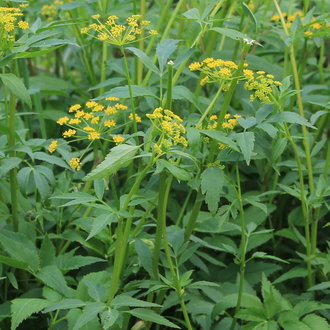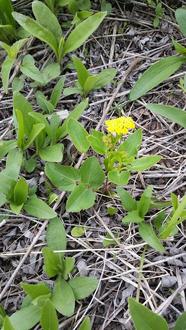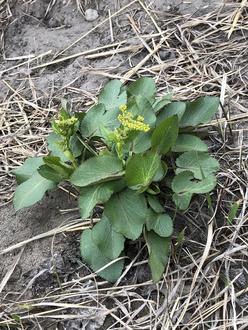Heart-Leaf Golden Alexander (Zizia aptera (A. Gray) Fernald)
Also known as meadow zizia.
↑Range - Expand
| Legend | Color |
| Native | |
| Native or Not Present |
This tentative map is based on our own research. It may have limited data on Canada and/or Mexico, and there is some subjectivity in our assignment of plants as introduced vs. expanded. Read more in this blog post.
Although this plant occurs somewhere in each of these regions, it may only occur in a small part of some or all of them.
This species' native range extends across much of southern Canada, but we have not yet built this portion of its range map.
↑Similar Plants
↑Habitat
Habitats vary regionally, and include black soil prairies, hill prairies, rocky upland forests, limestone glades, ridges of trap rock or diabase, dry open hillsides, and, especially towards the west of its range, on lakeshores and streambanks. Also found in anthropogenic habitats, including abandoned fields and roadsides. In New England, it is found on shell middens left by Native Americans, and often locally limited to such sites.
Found in a range of moisture conditions, from moist to dry, but usually absent from either extremes. Where it overlaps in range, this species is usually found on drier sites than the related golden alexanders (Zizia aurea), and is often less abundant than that species, but the two can co-occur in the same habitat. This species has a greater preference for soil moisture in the southern and western portions of its range, whereas in the northeast and upper midwest it is more frequent on dry sites. It prefers calcareous soils, and tolerates alkaline soil, and is absent from sites with acidic soil. It is usually found on well-drained sites, but it can tolerate clay soil, and in the west of its range it can be found on poorly-drained sites.
Can be found in habitats experiencing regular (as frequent as annual) fire, and may prefer such habitats and/or benefit from burning, particularly when it happens in the spring. Humans may sometimes create more habitat for this species by mowing, carrying out controlled burns, and removing forest canopies. At the same time, fire suppression and land management that favors closed-canopy forests may have decreased this species' habitat in other areas.
↑Life Cycle
This species is a perennial with a similar life cycle to Zizia aurea, blooming around the same time in late spring, with seed maturing in summer. Less is documented about its life cycle than Z. aurea; based on observations from gardens, this species may be relatively shorter-lived, but research has not yet established whether such observations extend to apply to wild plants. Basal foliage is evergreen in mild climates and may be slightly more likely than Z. aurea to remain evergreen, as we found more sources categorizing it as evergreen in spite of it being a less common plant.
This species may represent an opportunity for "low-hanging fruit" in terms of publishing observation of basic information such as timing of leaf emergence, conditions and timing of seed germination, whether and under which conditions it forms clones connected by rhizomes, how long-lived plants are in the wild in various habitats, whether or not it forms a seed bank, and if so, how long-lived it is.
Given the long-term seed-banking and irregular germination timing of Z. aurea, and that these features are relatively common in the Apiaceae family, and that this species also occurs in disturbed habitats where such traits would be adaptive, it is likely that this species also forms a long-term seed bank and that its seeds germinate irregularly, probably in response to disturbance.
This species' growth is likely limited more by competition from other plants in the richer habitats where it occurs in the south of its range, whereas it is likely limited more by harsh environmental conditions when it occurs in dry, calcareous habitats. However this has also not been verified.
↑Uses
This species is infrequently cultivated in gardens, but makes an excellent garden plant. It is easy to grow and similar in appearance to Z. aurea, and supports similar insects. It is suitable for growing in regions of the interior northwest outside the range of Z. aurea, and where both species are native, this one may be a locally better choice on sites that have drier conditions and/or calcareous soils.
↑Related Plants
This species overlaps in range with the more common, widely-distributed golden alexanders (Zizia aurea), as well as with meadow alexanders (Zizia trifoliata), which has a more limited distribution in the interior southeast, but is locally common. Both of these species are native.
The broader Selineae tribe also includes numerous other species, both native and introduced.
↑Links & External Resources
• Zizia aptera (Heartleaf Golden Alexanders) | Illinois Wildflowers (About This Site)
• Zizia aptera (meadow zizia) | USDA PLANTS Database (About This Site)
• Zizia aptera | Go Botany (About This Site)
• Zizia aptera (Meadow Zizia) | Missouri Botanical Garden Plant Finder (About This Site)
• Zizia aptera | Biota of North America Project (BONAP) (About This Site)
• Zizia aptera (A.Gray) Fernald | Plants of the World Online (POWO) (About This Site)
• Zizia aptera | NatureServe Explorer (About This Site)
• Heart-leaved Alexanders | Maryland Biodiversity Project (About This Site)
• Zizia aptera (Heart-leaved Alexanders) | Minnesota Wildflowers (About This Site)
• Zizia aptera (Gray) Fern. (Heart-leaf Golden-alexanders) | Digital Atlas of the Virginia Flora (About This Site)







